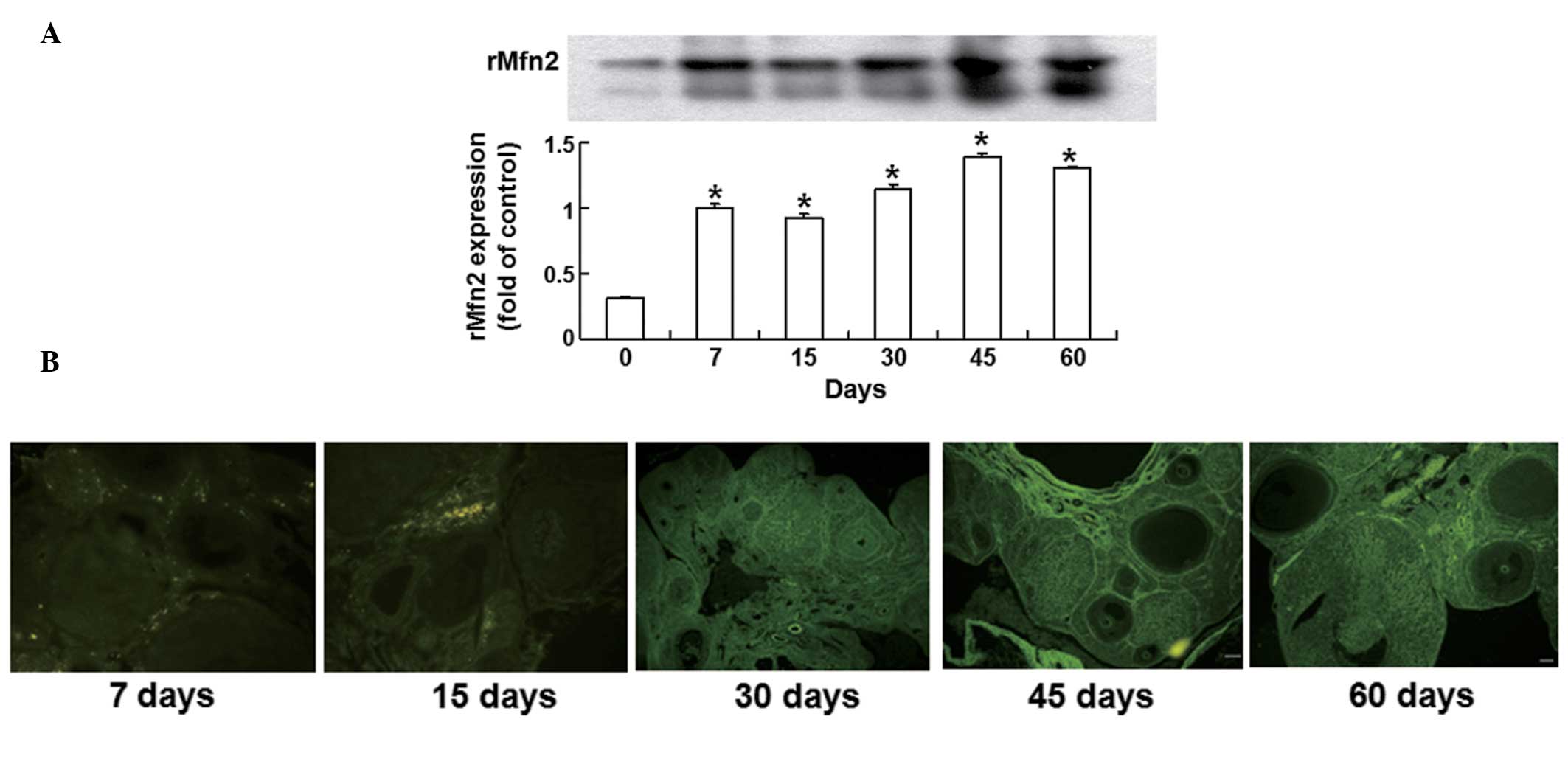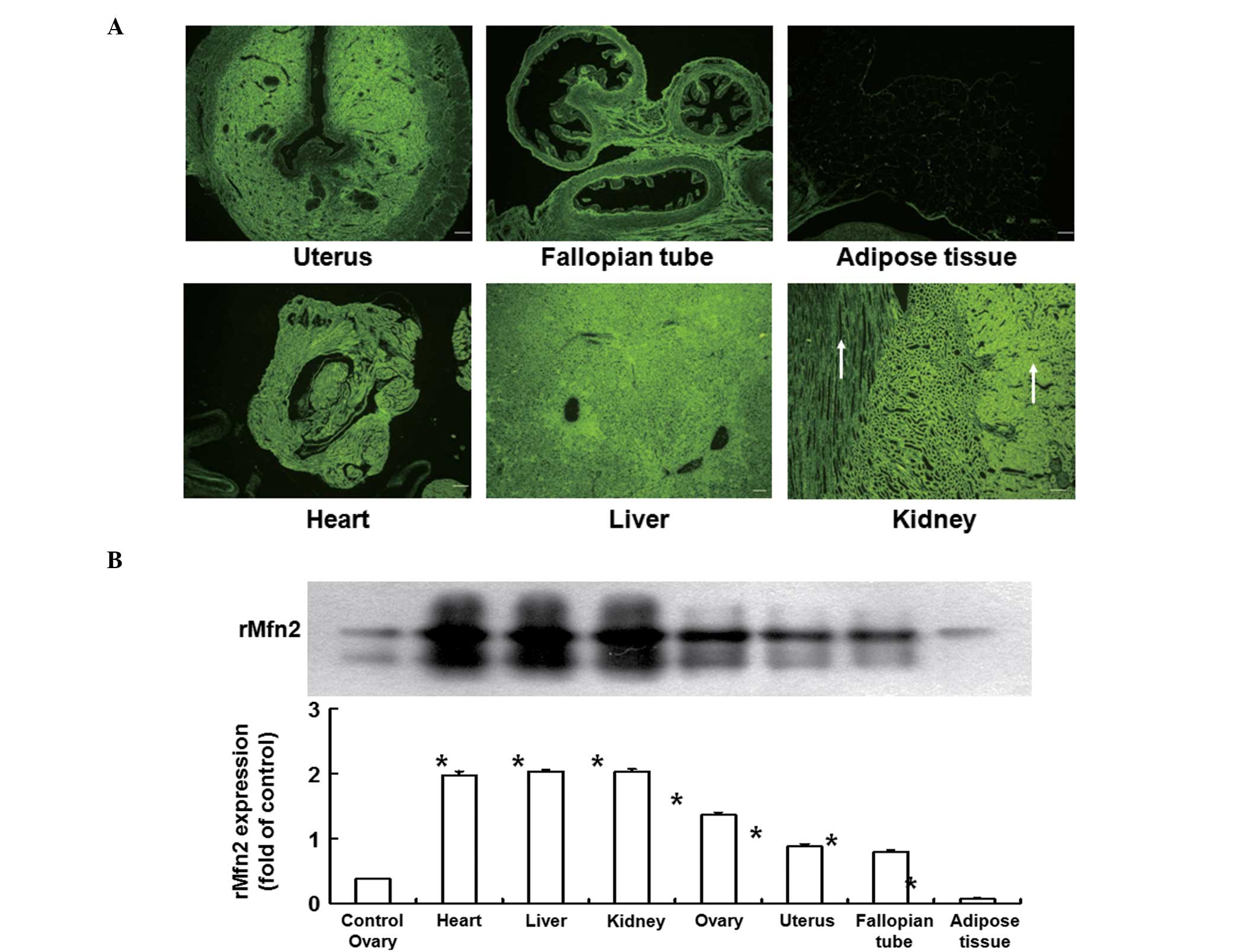|
1
|
Neuspiel M, Zunino R, Gangaraju S,
Rippstein P and McBride H: Activated mitofusin 2 signals
mitochondrial fusion, interferes with Bax activation, and reduces
susceptibility to radical induced depolarization. J Biol Chem.
280:25060–25070. 2005. View Article : Google Scholar
|
|
2
|
Züchner S, Mersiyanova IV, Muglia M, et
al: Mutations in the mitochondrial GTPase mitofusin 2 cause
Charcot-Marie-Tooth neuropathy type 2A. Nat Genet. 36:449–451.
2004.PubMed/NCBI
|
|
3
|
Kijima K, Numakura C, Izumino H, et al:
Mitochondrial GTPase mitofusin 2 mutation in Charcot-Marie-Tooth
neuropathy type 2A. Hum Genet. 116:23–27. 2005. View Article : Google Scholar : PubMed/NCBI
|
|
4
|
Zhu D, Kennerson ML, Walizada G, Züchner
S, Vance JM and Nicholson GA: Charcot-Marie-Tooth with pyramidal
signs is genetically heterogeneous: families with and without MFN2
mutations. Neurology. 65:496–497. 2005. View Article : Google Scholar : PubMed/NCBI
|
|
5
|
Chen H, Detmer SA, Ewald AJ, Griffin EE,
Fraser SE and Chan DC: Mitofusins Mfn1 and Mfn2 coordinately
regulate mitochondrial fusion and are essential for embryonic
development. J Cell Biol. 160:189–200. 2003. View Article : Google Scholar : PubMed/NCBI
|
|
6
|
Wu L, Li Z, Zhang Y, et al:
Adenovirus-expressed human hyperplasia suppressor gene induces
apoptosis in cancer cells. Mol Cancer Ther. 7:222–232. 2008.
View Article : Google Scholar : PubMed/NCBI
|
|
7
|
Bach D, Pich S, Soriano FX, et al:
Mitofusin-2 determines mitochondrial network architecture and
mitochondrial metabolism. A novel regulatory mechanism altered in
obesity. J Biol Chem. 278:17190–17197. 2003. View Article : Google Scholar
|
|
8
|
Kelley DE, He J, Menshikova EV and Ritov
VB: Dysfunction of mitochondria in human skeletal muscle in type 2
diabetes. Diabetes. 51:2944–2950. 2002. View Article : Google Scholar : PubMed/NCBI
|
|
9
|
Mogensen M, Sahlin K, Fernström M,
Glintborg D, Vind BF, Beck-Nielsen H and Højlund K: Mitochondrial
respiration is decreased in skeletal muscle of patients with type 2
diabetes. Diabetes. 56:1592–1599. 2007. View Article : Google Scholar : PubMed/NCBI
|
|
10
|
Petersen KF, Befroy D, Dufour S, et al:
Mitochondrial dysfunction in the elderly: possible role in insulin
resistance. Science. 300:1140–1142. 2003. View Article : Google Scholar : PubMed/NCBI
|
|
11
|
Petersen KF, Dufour S, Befroy D, Garcia R
and Shulman GI: Impaired mitochondrial activity in the
insulin-resistant offspring of patients with type 2 diabetes. N
Engl J Med. 350:664–671. 2004. View Article : Google Scholar
|
|
12
|
Guo X, Chen KH, Guo Y, Liao H, Tang J and
Xiao RP: Mitofusin 2 triggers vascular smooth muscle cell apoptosis
via mitochondrial death pathway. Circ Res. 101:1113–1122. 2007.
View Article : Google Scholar : PubMed/NCBI
|
|
13
|
Chen KH, Guo X, Ma D, et al: Dysregulation
of HSG triggers vascular proliferative disorders. Nat Cell Biol.
6:872–883. 2004. View
Article : Google Scholar : PubMed/NCBI
|
|
14
|
Wang W, Zhu F, Wang S, et al: HSG provides
antitumor efficacy on hepatocellular carcinoma both in vitro
and in vivo. Oncol Rep. 24:183–188. 2010.PubMed/NCBI
|
|
15
|
Ma L, Liu Y, Geng C, Qi X and Jiang J:
Estrogen receptor β inhibits estradiol-induced proliferation and
migration of MCF-7 cells through regulation of mitofusin 2. Int J
Oncol. 42:1993–2000. 2013.
|
|
16
|
Cheng X, Zhou D, Wei J and Lin J:
Cell-cycle arrest at G2/M and proliferation inhibition by
adenovirus-expressed mitofusin-2 gene in human colorectal cancer
cell lines. Neoplasma. 60:620–626. 2013. View Article : Google Scholar : PubMed/NCBI
|
|
17
|
Jin B, Fu G, Pan H, et al: Anti-tumour
efficacy of mitofusin-2 in urinary bladder carcinoma. Med Oncol.
28:373–380. 2011. View Article : Google Scholar : PubMed/NCBI
|
|
18
|
Wang P, Wu LN, Jiang CS, et al: Human
hyperplasic suppress gene (hHSG) could increase the chemotherapy
sensitivity of human tumor cells in vitro. Beijing Da Xue
Xue Bao. 37:117–120. 2005.(In Chinese).
|
|
19
|
Swisher SG, Roth JA, Komaki R, et al:
Induction of p53-regulated genes and tumor regression in lung
cancer patients after intratumoral delivery of adenoviral p53 (INGN
201) and radiation therapy. Clin Cancer Res. 9:93–101.
2003.PubMed/NCBI
|
|
20
|
Kim EY, Hong YB, Lai Z, Kim HJ, Cho YH,
Brady RO and Jung SC: Expression and secretion of human
glucocerebrosidase mediated by recombinant lentivirus vectors in
vitro and in vivo: implications for gene therapy of
Gaucher disease. Biochem Biophys Res Commun. 318:381–390. 2004.
View Article : Google Scholar : PubMed/NCBI
|
|
21
|
Hu Q, Chen C, Khatibi NH, et al:
Lentivirus-mediated transfer of MMP-9 shRNA provides
neuroprotection following focal ischemic brain injury in rats.
Brain Res. 1367:347–359. 2011. View Article : Google Scholar : PubMed/NCBI
|

















